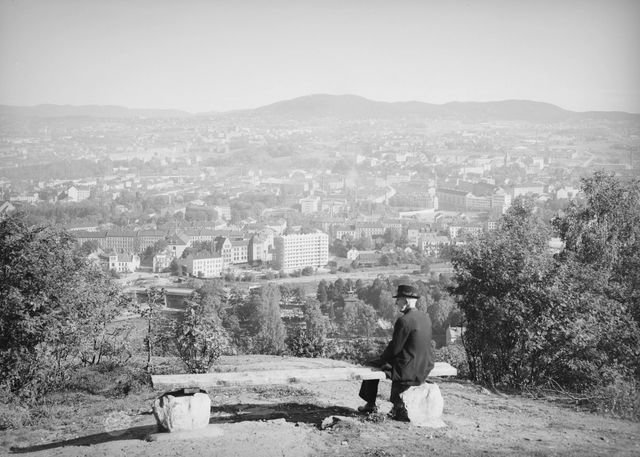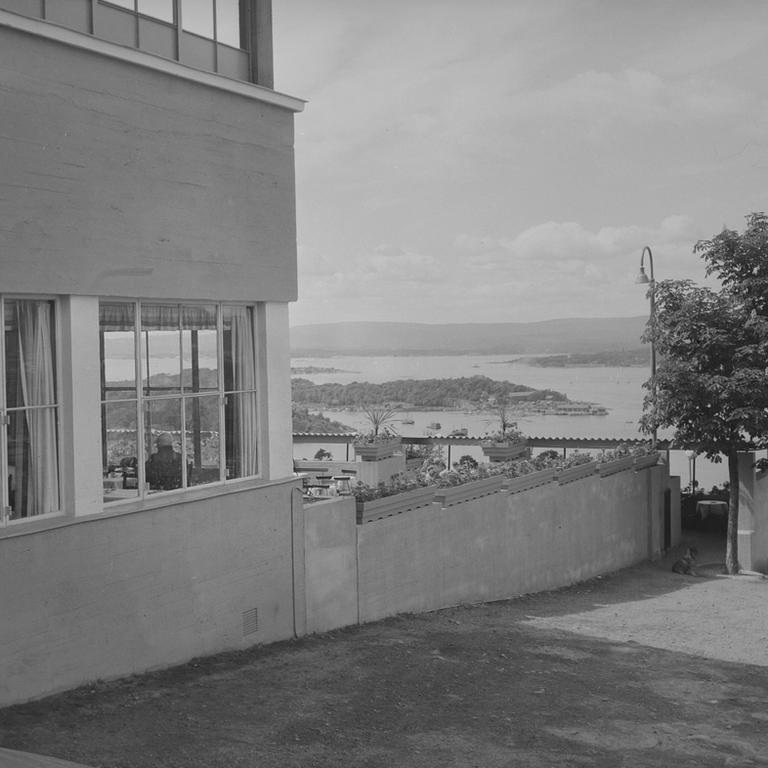In words and pictures: Ekeberg

Ekeberg farm
Ekeberg Manor is one of the oldest farms in the Oslo area. Traces of prehistoric houses over 3000 years old have been found at Ekeberg farm.
Today, the farm is a popular visitor farm and riding school. Among other things, therapeutic riding is offered. Visitors can ride, drive horse and carriage, and meet goats, pigs, and lambs that roam freely. There is also a café, playground, fire pit, and mini-golf nearby. Many school classes and kindergartens visit this place.
Ekeberg Line – The Old Oslo Line
The Ekeberg Line opened in 1917 and was built by A/S Ekebergbanen. It runs from Gamlebyen and has its own route along the road. When Aker municipality and Oslo municipality merged in 1948, the Ekeberg Line was connected to the city's tram network.
The tram was used as a means to get developers to build in the Nordstrand area, and was very popular before, during, and after World War II.

Ekebergrestauranten
The Ekebergrestauranten was built in 1927 for the Oslo municipality. It was designed by architect Lars Backer in the functionalist style and is considered one of Norway's finest buildings in this style
The restaurant was one of Oslo's most popular dance restaurants until the 1980s, when it was closed due to decay. It was completely renovated and reopened in 2005. Today it is owned by Christian Ringnes and the company Eiendomsspar.
Previously, the restaurant was colloquially known as "Åreknuten", because many considered it a dating spot for those over 60.
Ekeberg War Cemetery
Ekeberg war cemetery, also known as Ekeberg honor cemetery (in German Ehrenfriedhof), was established during World War II for German soldiers who fell in Norway. Many lost their lives in the Oslo area, especially after the sinking of the Blücher.
The municipality of Oslo did not want the war cemetery within the city itself, and suggested other locations on the outskirts of the city center. However, the Germans insisted on Ekeberg, justifying it with the notion that "Germans should lie high and free."
After the war, the soldiers' graves were moved to Alfaset. When the sculpture park was established, the City Antiquarian decided to preserve the staircase, which was a central part of the war cemetery and considered an important cultural monument. Today, the area is part of Ekebergparken, with wide paths, benches, several sculptures, views of the fjord, and a large field for play and activities with dogs, also known as 'dog flatland'.

Ekebergparken
Ekebergparken was opened in 2013 following an initiative by Christian Ringnes. The area itself is owned by the municipality of Oslo, while the park and sculpture collection are operated by the C. Ludens Ringnes Foundation. The park is beautifully situated on the Ekeberg slope, with a magnificent view of the fjord and the city.
The park's vision is to create a unique and diverse sculpture and cultural heritage park for the enjoyment and enrichment of the city's residents and visitors.
The park has good hiking trails, water features, and over 48 sculptures placed throughout the area. New sculptures will be added regularly over the next 50 years.
Paul McCarthy's six-meter-tall, red bronze sculpture "Santa" has found its place in a roundabout just below Ekebergparken.

Ekebergsletta
Ekebergsletta is best known for the Norway Cup – one of the world's largest football tournaments for children and youth. Each year, between 1600 and 1800 teams from 50–60 countries participate. The tournament is for players between the ages of 6 and 19.
On the edge of the fjord, you'll find Ekeberg Camping, with views over Oslo, the Oslofjord, Bjørvika, and Akershus Fortress. There is space for tents, motorhomes, and caravans. The campsite borders Ekebergparken and has walking paths down to the city.
Images and videos on other websites
- See more pictures at digitaltmuseum.no
- See more pictures at nasjonalbiblioteket.no
- Watch the film from the Agricultural Exhibition at Ekeberg 1959